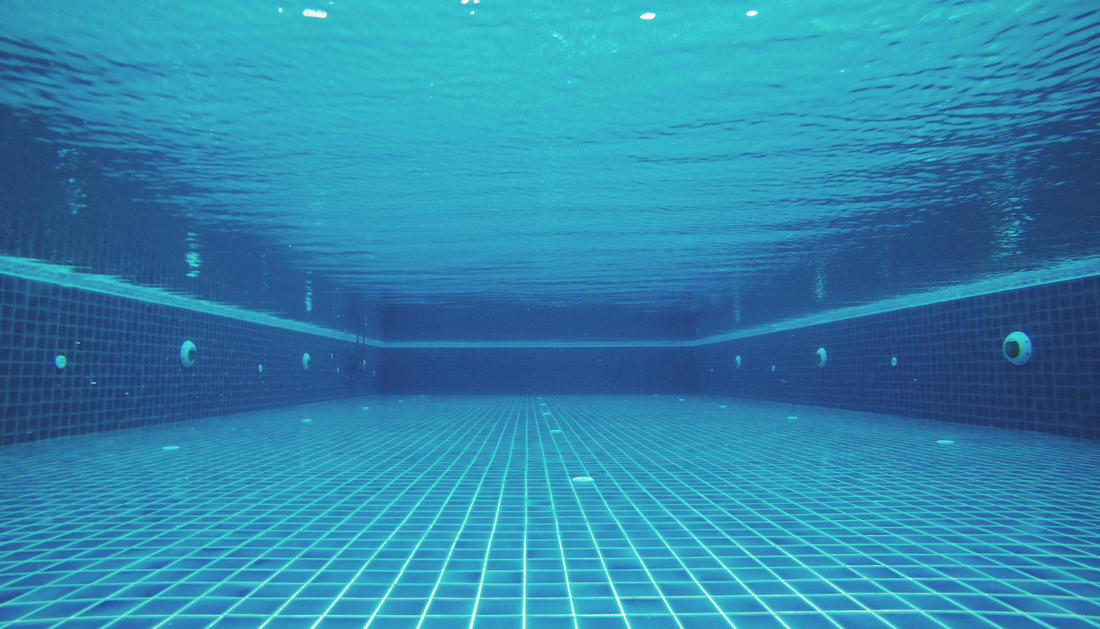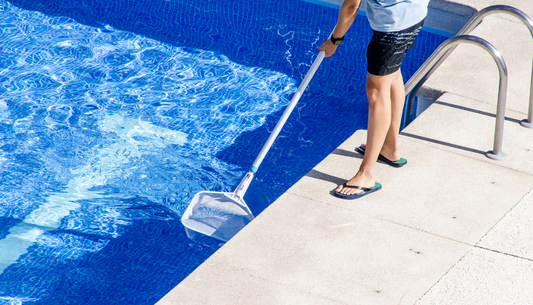
How Do I Make My Pool Water Crystal Clear? | Pool Guide.

Pool test kits are key to checking your pool's health. They measure chlorine, alkalinity, and water hardness. Aim for 1 to 3 parts per million (ppm) of chlorine. The pH should be between 7.2 and 7.8, with 7.6 being ideal for clear water.
Baking soda can boost your pool's alkalinity to 110 to 115 ppm. For a 10,000-gallon pool, add 3 to 4 pounds of baking soda if the pH is low. Regular water tests ensure all chemicals are balanced, leading to clear water.
Clarifying tablets and solvents are crucial for removing tiny particles and debris. Running the filter pump for at least 8 hours a day is also important. Keeping the pH and chlorine levels right and shocking the pool weekly will keep your pool clear and sparkling.
The Importance of Pool Water Clarity
Keeping your pool water clear is key for looks, health, and safety. Clear water means you can swim without seeing murky stuff or hidden dangers. It makes swimming better and keeps the pool clean.
Clear water shows your pool is well-kept. The right pH levels, between 7.4 and 7.6, are important. Also, cleaning the pool regularly helps. This includes brushing walls, vacuuming, and cleaning filters.
A cloudy pool can hide harmful bacteria and cause accidents. Using tools like flocculants can help clear the water. These tools make it easier to vacuum up dirt and keep the water clear.

Sticking to a regular maintenance plan is crucial. This includes skimming the surface and testing the water often. Shocking the pool weekly and using algaecides after rain also helps keep the water clean.
Preventing murky water is all about routine checks. Keeping free chlorine levels between 0.3 and 0.5 mg/L is important. Following these steps can make your pool last longer and be safer to swim in.
| Factor | Ideal Range |
|---|---|
| pH Level | 7.4 - 7.6 |
| Alkalinity Level | 100 - 150 ppm |
| Free Chlorine Level | 0.3 - 0.5 mg/L |
Balancing the Water Chemistry
Keeping the water chemistry in balance is key for a healthy pool. It ensures the water is clear and safe for swimmers. It also protects the pool equipment from damage.

Understanding pH Levels
The ideal pH levels in pools are between 7.4 and 7.6. This range keeps swimmers comfortable and helps the pool last longer. It's important to test the pH levels weekly and adjust them as needed.
Maintaining Alkalinity
Alkalinity helps keep the pH levels stable. It should be between 80 to 150 ppm. Testing alkalinity weekly and using increasers like sodium bicarbonate keeps it balanced.
Managing Calcium Hardness
Calcium hardness prevents scale and cloudiness. It should be between 200 to 400 ppm. If it's too low, add a calcium increaser. If it's too high, you might need to drain and refill the pool.
| Chemical | Ideal Range | Frequency of Testing |
|---|---|---|
| pH Levels | 7.4 - 7.6 | Weekly |
| Pool Alkalinity | 80 - 150 ppm | Weekly |
| Calcium Hardness | 200 - 400 ppm | Weekly |
Effective Chlorine Usage
Chlorine is key to keeping pool water clear. It kills harmful bacteria, viruses, and algae. Knowing how to use chlorine helps keep your pool safe and inviting.
Benefits of Chlorine Tablets
Chlorine tablets are easy to use for pool care. They slowly release chlorine, keeping levels right. They also have stabilizers to protect against UV rays, making them last longer.
Maintaining Ideal Chlorine Levels
It's important to keep chlorine levels just right in your pool. Test them often, especially in summer when it's hotter. The right levels prevent cloudy water and keep it safe.
If chlorine levels are off by 0.3 ppm, you might need to shock the pool. This clears up the water.
Alternative Disinfection Methods: Active Oxygen
Alternative pool disinfectants like active oxygen are gentler. They're less harsh on eyes and skin. But, they need to be used more often.
Using active oxygen for pool care is more work. But, it's better for your health and the environment.
Proper Filtration Techniques
Keeping your pool water clear and safe is key. It's important to know about pool filtration systems. This includes picking the right filter, doing regular maintenance, and making sure the pump works right.
Choosing the Right Filter
When choosing pool filters, think about your pool's size, how often you use it, and what it needs. There are three main types: sand, cartridge, and diatomaceous earth (DE) filters. Each has its own benefits:
- Sand Filters: Easy to use and maintain; great for big pools.
- Cartridge Filters: Better at filtering than sand; need less cleaning.
- Diatomaceous Earth Filters: Best at filtering but need more upkeep and backwashing.
Choose the filter that best fits your pool's needs.
Regular Filter Maintenance
Keeping your filter in good shape is crucial. The type of filter you have determines how you should maintain it:
| Filter Type | Maintenance Tasks | Frequency |
|---|---|---|
| Sand Filters | Backwash | Weekly |
| Cartridge Filters | Clean cartridges | Every 4-8 weeks |
| DE Filters | Backwash and recharge DE powder | As needed, typically monthly |
Backwashing sand filters, cleaning cartridge filters, and recharging DE filters keeps your pool water clean.
Proper Pump Operation
The pool pump is vital for clear water. Run the pump for at least 8 hours a day. This ensures water moves well, chemicals spread evenly, and filters work better.
- Check pump and skimmer baskets frequently: Remove debris to improve flow.
- Monitor water levels: Keep them right for the best pump performance.
- Regularly inspect the pump: Look for leaks, odd noises, or problems.
By keeping the pump running right, you make your filtration system last longer. And your pool water stays clear.
How Do I Make My Pool Water Crystal Clear?
To get your pool water crystal clear, you need to know what makes it cloudy. You also need to use the right tools to fix it. By finding out why your pool water is cloudy and using the right products, you can keep it clean and clear.
Identifying Common Causes of Cloudiness
Knowing why your pool water is cloudy is key to keeping it clean. Cloudiness can come from not using the right chemicals, not filtering well enough, or from debris. Low chlorine, bad water balance, poor circulation, and too much Calcium Hardness or Total Dissolved Solids can also make water cloudy. Weather and more people swimming can add to the problem.
Usage of Pool Clarifiers and Flocculants
Pool clarifiers and flocculants are great for clearing cloudy water. Products like Leslie’s Ultra Bright Advanced help catch tiny particles. Flocculants work fast, especially with certain filters. Using these products often keeps your water clear.
Cleaning and Shocking the Pool
Cleaning and shocking your pool regularly is important for clear water. Shocking with chlorine-based products can really help. It's also key to keep an eye on your water's pH and Total Alkalinity levels. Running your filter all the time and cleaning it often helps too.
By following these steps and taking good care of your pool, you can have clear water all season.
Preventing Algae and Bacteria Growth
Keeping your pool clean and clear is key. It involves stopping algae and bacteria from growing. These can quickly ruin your pool's look. Here's how to keep your pool water inviting all season:
- Circulation: Make sure your pool’s pump and filter run for 8-12 hours a day. This keeps the water moving and clean, stopping algae and bacteria.
- Filtration Time: Run the filter for 24 to 48 hours after using algaecides and shock treatments. This helps remove dead algae.
- Correct Water Chemistry: Keep the water chemistry balanced. Aim for pH levels between 7.2 and 7.6 and chlorine levels between 1.0 and 3.0 ppm. This stops algae and bacteria from growing.
Regular care is vital for algae and bacteria treatments. Shock the pool weekly and use algaecides to stop these organisms. Also, cover the pool when not in use to reduce sunlight and algae growth.
| Common Types of Algae | Characteristics | Prevention Tips |
|---|---|---|
| Green Algae | Most common, often found in areas with poor circulation | Ensure proper filtration and circulation, regular brushing |
| Black Algae | Very resistant, clings to walls, floors, and cracks | Use algaecides and intense brushing, maintaining proper chlorine levels |
| Mustard or Yellow Algae | Chlorine and shock-resistant, grows in shady areas | Apply specialized algaecides, regular pool shocking |
Vacuuming, skimming, and swimming often can help remove algae spores. This helps in controlling bacteria in swimming pools. Regular maintenance keeps your pool a healthy and refreshing place.
Routine Pool Maintenance Tips
Keeping your pool clean requires a regular maintenance routine. This routine boosts water quality and extends your pool's life. Techniques like skimming, vacuuming, and brushing walls are key to a clean, safe pool.
Skimming and Brushing
Skimming your pool every day is crucial. It removes floating debris like leaves and insects. This step stops organic material from building up, which can lead to algae and cloudy water.
Brushing your pool walls and floors once a week is also important. It loosens dirt, algae, and minerals stuck to the surfaces. This makes vacuuming more effective.
Regular Vacuuming
Vacuuming your pool regularly cleans the floor, walls, and waterline. It prevents dirt and debris from building up. Vacuuming at least once a week keeps your pool looking good and prevents stains.
Scheduling Maintenance
Having a solid pool maintenance schedule is key. It should include daily skimming, weekly brushing, and vacuuming. Also, check chemical levels and filter systems often.
Regularly inspect your pump and filter systems. This ensures good water flow and prevents cloudy water and algae.
Handling Environmental Factors
It's key to know how pool environmental factors impact your pool's water clarity. Weather changes can affect your pool's water quality, so you need to adjust your care routine. For example, storms can bring in extra debris and contaminants, causing cloudiness or algae.
Using a pool cover can help keep out leaves and dust. This simple step can cut down on maintenance needs and keep your pool clean longer.
Other environmental factors include pollen, tree debris, and landscaping runoff. These can mess with your pool's water chemistry, causing pH imbalances and cloudiness. Keeping pH levels between 7.2 and 7.8 and stabilizer levels at 30-50 ppm helps prevent algae.
Testing and adjusting chemical levels regularly is smart. Watch the levels of free chlorine, total alkalinity, and calcium hardness. Here are some tips:
- Skimming and vacuuming: Regularly remove debris to prevent build-up and maintain water clarity.
- Use of pool covers: Covering your pool when not in use shields it from debris and contaminants.
- Adjusting treatment protocols: Post-storm or heavy use scenarios necessitate adjustments in your water treatment processes.
By following these steps, you can keep your pool healthy and safe for swimming. Regular care extends your pool's life and keeps it clear, making it a great place to relax, rain or shine.
Special Considerations for Different Pool Types
Each swimming pool type has its own maintenance needs. Whether it's an above-ground, in-ground, fiberglass, or vinyl-lined pool, knowing these pool type considerations is key. It helps keep your pool looking great and safe for swimming.
Fiberglass pools are easy to maintain in the short term. Their smooth surfaces help keep water chemistry stable. This means you don't need to treat the water as often. Plus, many fiberglass pools come with a lifetime guarantee on color and finish.
Vinyl-lined pools are affordable to install but need careful attention. You must check the liner for damage and fix it quickly. Keeping the water chemistry balanced is also important to prevent liner damage.
In-ground concrete pools are durable but need regular care. They can get algae, so brushing the walls often and keeping the water balanced is crucial. Sand or DE filters work best for these pools.
Above-ground pools face more environmental challenges. They need strong filtration and regular cleaning. Using Alum or Cellulose Fiber can help the filter work better, making upkeep easier.
Keeping your pool water clear is a must, no matter the type. You should regularly check and adjust pH, Total Alkalinity, and Calcium Hardness levels. Skimming, brushing, vacuuming, and shocking the pool are essential for clean water and a safe swim.
By matching your care routine to your pool's specific needs, you can enjoy it for years to come. It's all about keeping your pool in top shape.
FAQ
How do I make my pool water crystal clear?
To get crystal clear pool water, keep the chemistry right, filter well, and maintain regularly. Balance pH, alkalinity, and calcium hardness. Use chlorine tablets or active oxygen for disinfection. Make sure filters and pumps work well.
Why is pool water clarity important?
Clear pool water is key for hygiene and safety. It looks good and stops harmful bacteria. It also keeps the pool safe and equipment working long.
What pH levels should I maintain in my pool?
Keep pH between 7.0 and 7.4. This stops irritation and protects equipment. Test and adjust with pH increasers or decreasers.
How do I maintain alkalinity in my pool water?
Alkalinity should be 100 to 150 ppm. Use increasers or decreasers to keep it stable. This prevents pH swings that harm water and equipment.
Why is calcium hardness important?
Right calcium hardness stops scale and cloudy water. Keep it 200 to 400 ppm. Adjust with increasers or decreasers for clear water and long equipment life.
What are the benefits of using chlorine tablets?
Chlorine tablets keep chlorine levels steady, 0.3 to 0.5 mg/L. They kill bacteria and algae. They also have stabilizers to protect against UV damage.
How do I maintain ideal chlorine levels in my pool?
Test chlorine levels often and adjust to keep them between 0.3 and 0.5 mg/L. Use tablets in a dispenser or chlorinator for steady levels.
Are there alternative disinfection methods to chlorine?
Yes, active oxygen is a gentler option. But, it needs more frequent use and checking to keep water clean.
How do I choose the right filter for my pool?
The right filter depends on your pool size and use. Choose from sand, cartridge, or diatomaceous earth filters. Each has its own upkeep needs.
How should I maintain my pool filter?
Keep your filter in top shape with regular care. Backwash sand filters, replace cartridges, and recharge diatomaceous earth filters as needed.
What is the importance of proper pump operation?
Running the pump right ensures water moves well. This stops stagnation and spreads chemicals evenly. Aim for at least 8 hours daily.
What are the common causes of cloudy pool water?
Cloudy water often comes from bad chemistry, poor filtration, or debris. Test and adjust chemistry, filter well, and clean often to avoid it.
How do I use pool clarifiers and flocculants?
Clarifiers and flocculants gather small particles for easy filtering. Add as directed and run the filter to clear out debris.
How often should I clean and shock my pool?
Clean and shock your pool regularly, at least weekly. Shocking breaks down waste and bacteria, keeping water clear.
How can I prevent algae and bacteria growth in my pool?
Use algaecides, keep chlorine levels up, and ensure water moves well. Remove still water and balance chemistry to keep your pool clean.
What routine maintenance tips should I follow for my pool?
Skim daily, brush and vacuum walls and floor, and check chemicals and filters often. A maintenance schedule helps keep water quality consistent.
How do environmental factors impact pool clarity?
Weather, debris, and runoff can cloud your pool. Use covers and adjust treatments for heavy use or storms to keep water clear.
Are there special maintenance considerations for different pool types?
Yes, different pools need different care. Know the specific needs for cleaning, filters, and chemicals to keep your pool in top shape.

